WRITER CARL MAYER (1894-1944)
FILMOGRAPHY
- Das Cabinet des Dr. Caligari
(1920, Robert Wiene)
- Johannes Goth (1920, Karl Gerhardt)
- Der Bucklige und die Tänzerin (1920, F.W. Murnau)
- Genuine (1920, Robert Wiene)
- Der Dummkopf (1921, Lupu Pick)
- Der Gang in die Nacht (1921, F.W. Murnau)
- Torgus (1921, Hanns Kobe)
- Schloß Vogelöd (1921, F.W. Murnau)
- Scherben (1921, Lupu Pick)
- Grausige Nächte (1921, Lupu Pick)
- Hintertreppe (1921, Leopold Jessner)
- Vanina (1922, Arthur von Gerlach)
- Erdgeist (1923, Leopold Jessner)
- Der Puppenmacher von Kiang-Ning (1923, Robert Wiene)
- Sylvester (1924, Lupu Pick)
- Der letzte Mann (1925, F.W. Murnau)
- Tartüff (1926, F.W. Murnau)
- Sunrise (1927, F.W. Murnau)
- Berlin, Die Sinfonie einer Großstadt (1927, Walther Ruttmann)
- Four Devils (1928, F.W. Murnau)
- Fräulein Else (1929, Paul Czinner)
- Die letzte Kompagnie (1930, Kurt Bernhardt)
- Stürme über dem Montblanc (1930, Arnold Fanck)
- Der Mann, der den Mord beging (1931, Kurt Bernhardt)
- Ariane (1931, Paul Czinner)
- Emil und die Detektive (1931, Gerhard Lamprecht)
- Das blaue Licht (1932, Leni Riefenstahl)
- Der träumende Mund (1931, Paul Czinner)
- As You Like It (1936, Paul Czinner)
- Dreaming Lips (1937, Paul Czinner)
- Pygmalion (1938, Anthony Asquith, Leslie Howard)
- The Fourth Estate (1940, Paul Rotha)
- Major Barbara (1941, Gabriel Pascal)
- World of Plenty (1943, Paul Rotha)
 back
to top
back
to top
ABSTRACT
Austrian Carl Mayer became German cinema's finest scriptwriter. In 1919, frustrated
by his job at the Berlin Residenztheater and in dire need of some money, he
was looking for a job in film industry, and co-scripted THE CABINET OF DR. CALIGARI (1920) with Hans Janowitz. A friend of them, actress Gilda Langer,
had already starred in a couple of films, and finally signed a contract with
Decla Film-Gesellschaft, the company that would ultimately purchase Mayer's
and Janowitz' script and produce CALIGARI. Following that, Mayer went
on to script such remarkable films as CALIGARI-successor GENUINE
(1920), "Kammerspielfilme" SCHERBEN (1921), HINTERTREPPE
(1921) and SYLVESTER (1924), and Murnau's classics DER LETZTE MANN
(1925) and SUNRISE (1927, recently made number 7 on a Sight &
Sound critic's all-time favourite poll). Mayer collaborated with directors
F.W. Murnau, Lupu Pick, Paul Czinner, and Paul Rotha, friend of Mayer's London
years, who described him thus: "An autumn leaf floating on a soft wind;
always a smile in those eyes. That was the image of Carl which I carried with
me when not in his company, and that is the image I have today -- nearly thirty-six
years after his death. He never wore a hat to cover his mass of luxurious hair.
Sometimes he resembled Beethoven. His clothing was always nondescript. You could
never hear him walk. He would just appear, with the same smiling greeting, "Hallo,
Paul!"" Mayer died in London, and is buried on Highgate Cemetery.
 back
to top
back
to top
SOURCES
The following documents are registration forms confirming Mayer's residence
in Vienna in the 1910s. Reprinted by friendly permission of the Wiener Stadt-
und Landesarchiv.
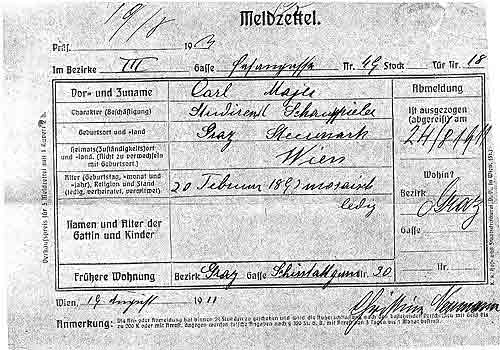
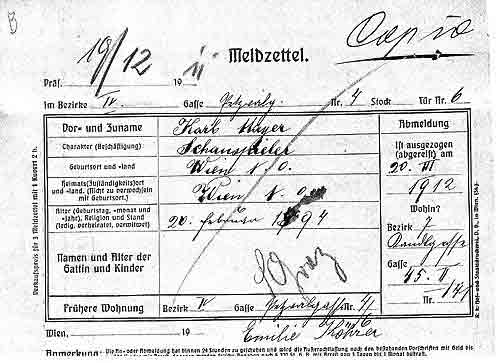

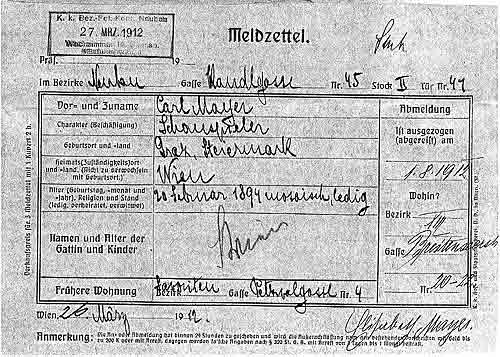
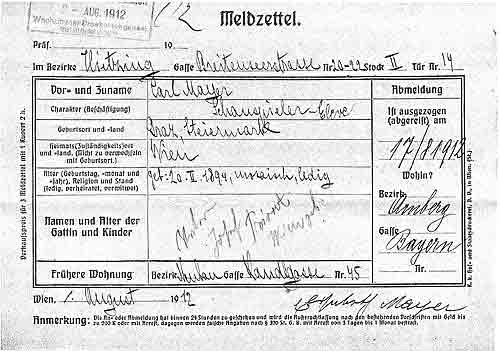
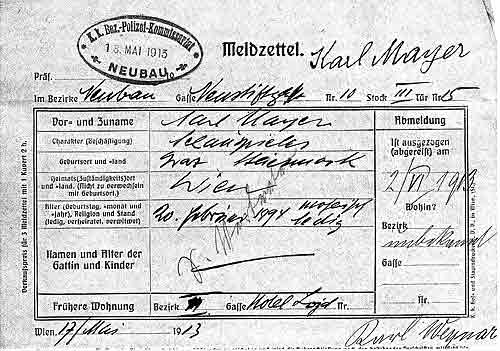
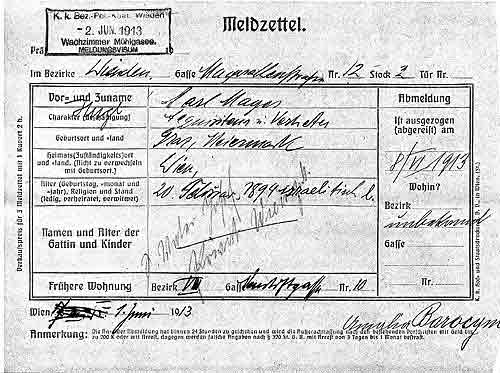
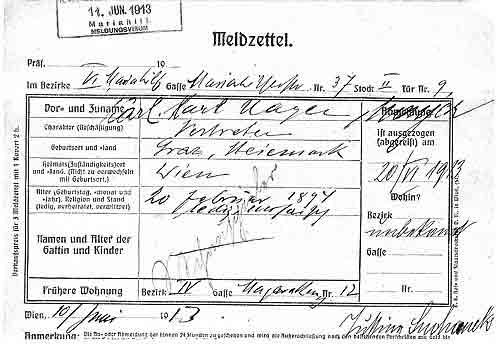
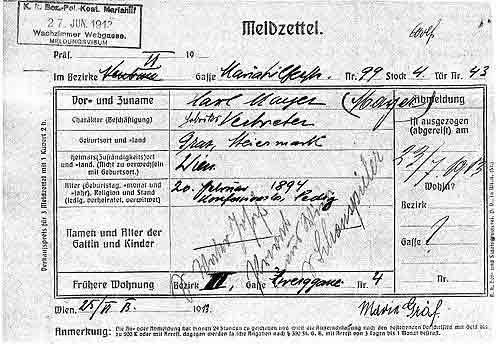
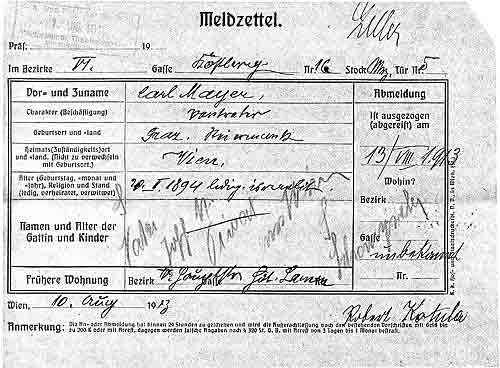
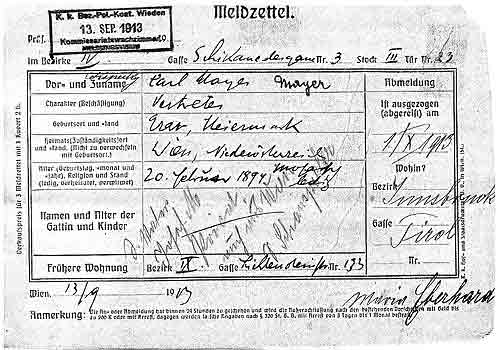
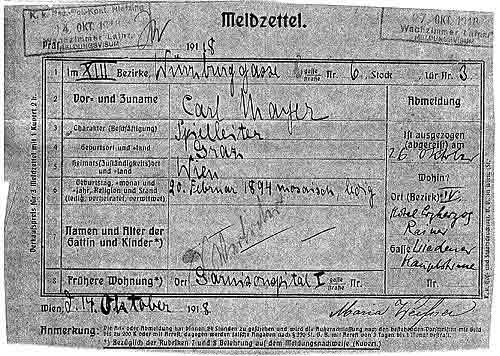
 back
to top
back
to top
LITERATURE
- Hempel, R. 1968: Carl Mayer, Ein Autor schreibt mit der Kamera. Berlin/
DDR: Henschel.
- Janowitz, H. 1940: "Caligari", The Story of a Famous Story. Unpublished
typescript, New York Public Library (NYPL), Billy Rose Theatre Collection
(the Stiftung Deutsche Kinemathek, Berlin has a photocopy).
- Janowitz, H. 1952: In memoriam Carl Mayer (1894-1944). New York 1952. Unpublished
handwritten note-book, Stiftung Deutsche Kinemathek, Berlin.
- Janowitz, H. 1953: A Chapter about Carl Mayer and his World without Words.
New York 1952/ 53. Unpublished typescript, Stiftung Deutsche Kinemathek, Berlin.
- Kasten, J. 1994: Carl Mayer: Filmpoet, Ein Drehbuchautor schreibt Filmgeschichte.
Berlin: VISTAS.
- Luft, H. G. 1954: Notes on the World and Work of Carl Mayer. The Quarterly
of Film, Radio & Television no. 4, pp. 375-392.
- Luft, H. G. 1968: Carl Mayer, Screen Author. Cinema Journal Fall 1968, pp.
29-38.
- Luft, H. G. 1972: Carl Mayer, Film Scriptwriter Extraordinary Of Post-World
War I Germany. Films in Review no. 9, pp. 513-526.
- Omasta, M. / Mayr, B. / Cargnelli, C. (eds.): Carl Mayer Scenar[t]ist, Ein Script von ihm war schon ein Film, "A script by Carl Mayer was already a film". Vienna: SYNEMA -- Gesellschaft für Film und Medien 2003.
- Rotha, P. 1938: It's in the Script. World Film News September 1938, pp.
204-205.
- Rotha, P. (ed.) 1947: A Tribute to Carl Mayer, 1894-1944, Memorial Programme.
- Rotha, P. 1980: Carl Mayer in England. Unpublished typescript, Stiftung
Deutsche Kinemathek, Berlin.
 general
literature
general
literature
 back
to top
back
to top
filmhistoriker.de,
edited by olaf brill.
Last update (this page): 21 Jul 2004.
The texts and images on this site are copyright © by the respective authors,
except where otherwise noted. Mostly, the items were published by kind permission,
but we were not able to find out all the copyright holders or their legal successors.
If you know about them, please let us know, especially if there's anything wrong
with publishing these texts or images. We do not intend to harm anyone's rights
and thought we best serve the purpose of understanding film and general history
displaying this source material and make it available for everyone.
If no author or source is noted, the texts are copyright © 1996-2006 Olaf
Brill.
 Impressum
Impressum  Datenschutz
Datenschutz
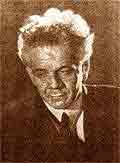













![]() Impressum
Impressum ![]() Datenschutz
Datenschutz